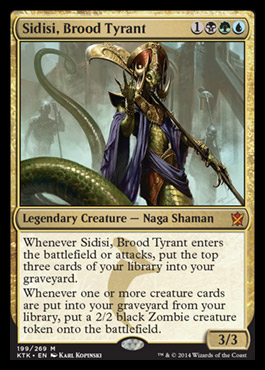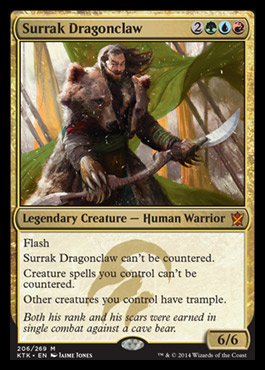First things first: the gods of Commander have spoken, and we have some churn on the Banned list, viewable here. They have done away with the “banned as your commander” category, and the cards that previously fell within that category are now either banned or unbanned, based on their level of brokenness. As such, [casthaven]Erayo, Soratami Ascendant[/casthaven], [casthaven]Braids, Cabal Minion[/casthaven], and [casthaven]Rofellos, Llanowar Emissary[/casthaven] are all banned, and rightly so! Those cards are universally unpleasant to play against. Rofellos jumps people unreasonably ahead, usually dropping an eldrazi on your head before anyone else has defenses raised. Braids is another [casthaven]Smokestack[/casthaven] effect, the sole purpose of which is to lock people out of the game. And Erayo is literally the least pleasant card I’ve ever tangled with. Back when it was legal as a commander, I once played against an Erayo deck that played (and flipped!) the stupid thing on turn two, and then dropped a [casthaven]Waterfront Bouncer[/casthaven] just to make sure that if I managed to brute-force a creature through the auto counter, which was hard enough to do given it activated when I only had one land in play, he could just untap and bounce the thing back to my hand. It was miserable, and it’s colored my opinion of that card ever since.
But the unbannings were even more interesting. [casthaven]Kokusho, the Evening Star[/casthaven] is allowed full reign again, which seems fine. Yes, the card can do brutal things, but with [casthaven]Exsanguinate[/casthaven], [casthaven]Gray Merchant of Asphodel[/casthaven], and [casthaven]Debt to the Deathless[/casthaven], that effect is just now part of the Commander landscape. You have to be used to those life swings!
The coolest thing is that [casthaven]Metalworker[/casthaven] is unbanned, finally. I mean, who knows, maybe it will get banned again in a few months, but in the meantime I am excited for the possibilities it offers. I’ve played around with the [casthaven]Metalworker[/casthaven] deck in Legacy, and I always wanted to explore the amazing things it allows in a less cutthroat format. If you want to see more about my [casthaven]Metalworker[/casthaven] thoughts, check out this week’s Dear Azami column, expressively called “Metalwhaaaaaa?”
Anyway, back to the topic at hand, which is the preexisting wedge generals, and how the Khans of Tarkhir stand up. Last week, as some of you might remember, we discussed Mardu, Abzan, and Jeskai. This week, that leaves us with Sultai, and the now released Temur general, [casthaven]Surrak Dragonclaw[/casthaven]. So let’s begin!

Just a kinda racially problematic evil South-East-Asian-themed snake lady, nothing to see here! It’s not like she’s a literal dragon lady or anything, right? OH WAIT!
[casthaven]Sidisi, Brood Tyrant[/casthaven] – Sultai/BUG/Team America
The Sultai wedge does two things well: disruption and self-mill. Another wedge somewhat screwed on the Elder Dragon throwback generals, [casthaven]Vorosh, the Hunter[/casthaven] did very little to work with these themes. Its whole deal is that when it hits an opponent it grows. This is… odd. It can’t kill an opponent in fewer than three hits without help, and it’s not even reliably a three hit kill since the counters reset whenever it’s swept from the board. What Vorosh does, though, is give Sultai wedge decks some freedom to play around with different themes.
Of course, if you want to play with different themes, you should probably just run [casthaven]Damia, Sage of Stone[/casthaven]. For one more mana you get a 4/4 deathtouch creature that, in many ways, tangles better than the big dumb flying dragon. And that’s not even why you run her! You run her because of her secondary ability: she lets you draw up to seven cards in your hand during your update, no matter how many cards you happen to have spammed out. Damia tends to be the choice general for the control player, but there’s really no reason to restrict her to that archetype; Damia has the versatility of Vorosh, but on a card you’d actually feel reasonable playing.
But why play BUG without touching on a self-mill or graveyard theme? You’re running the best colors to feed your ‘yard and get things back from it, with [casthaven]Archaeomancer[/casthaven], [casthaven]Eternal Witness[/casthaven], and [casthaven]Gravedigger[/casthaven] providing redundancies for one another. And if you tire of the basic versions, you can play all sorts of takes on those three cards, from [casthaven]Nyx Weaver[/casthaven] to [casthaven]Praetor’s Counsel[/casthaven]. Up until now, the no-brainer choice of general for this type of deck was [casthaven]The Mimeoplasm[/casthaven]. The problem with [casthaven]The Mimeoplasm[/casthaven] is that it’s stupid easy to build that deck to combo, usually since three or four of your combo pieces are worth playing on your own merit. If one of your opponents slams down a [casthaven]The Mimeoplasm[/casthaven] deck, it’s safest to assume they’ll combo and disrupt them accordingly.
Which leads us to [casthaven]Sidisi, Brood Tyrant[/casthaven], aka Dr Mrs [casthaven]The Mimeoplasm[/casthaven]. I disliked her to start, but the more I’ve been considering it the more I think it meets the need for a less frightening self-mill general. There’s less of a concern that Sidisi decks are going to combo you out, since they’re not keeping one of their combo pieces in the command zone until they kill you from nowhere. Sidisi is a self-mill enabler, not something that takes (much) direct advantage from the self-mill itself. Plus, there might be some interesting design space she opens for Sultai tokens. She is a token-maker, after all, and it’s not like BUG is a color combination that’s bad at making tokens. Hell, it’s even one of the rare color combinations that can play [casthaven]Garruk Relentless[/casthaven], which is an irritatingly rare feat indeed.

Dr Mrs The Mimeoplasm is a great name! No need to roll your eyes at the things I find amusing.

Whereas this guy is nowhere near as cool as his bear punching would imply.
[casthaven]Surrak Dragonclaw[/casthaven] – Temur/RUG
And now we’re up to the final wedge, Temur. Temur, for too long, has had a busted piece of the color wedge. Not only did it have the second-best Elder Dragon throwback, [casthaven]Intet, the Dreamer[/casthaven], but it also got an extra general in one of the Planechase products. But I’m getting ahead of myself; let’s look at Intet a little more carefully. Intet is a “deck order matters” card. Some cards like it if you stack the top of your deck. I tend to like those cards, so I’m a little overly familiar with the theme, but the basic thrust of it is that you run cards like [casthaven]Scroll Rack[/casthaven] and [casthaven]Crystal Ball[/casthaven] to make sure you’re getting the best possible thing with your free Intet card. I mean, “free,” since you have to hit with Intet and then pay three mana, but that’s a pretty steep discount if you’re snagging an endgame card.
So when Commander I came around, and the Temur wedge was gifted with two new Commanders, it was unsurprising that both the new options were above the curve. RUG is all about doin’ stuff, and boy did Commander deliver on that front. First, it gave us [casthaven]Animar, Soul of Elements[/casthaven]. This card is bonkers for two reasons. Primarily, it gives a gigantic mana reduction on the creatures that most decks play. When combined with a card draw engine like [casthaven]Soul of the Harvest[/casthaven], that can get out of hand very fast. Secondarily, though, if it’s in a losing position it can turn into a commander damage deck. Looping a card like [casthaven]Man-o-War[/casthaven] lets you add a +1/+1 counter for a single blue mana; can you imagine how gross the deck is going to be when [casthaven]Hardened Scales[/casthaven] joins the party?
As if that weren’t enough, Animar was paired off with [casthaven]Riku of Two Reflections[/casthaven], aka one of the most bonkers engines ever printed. Sure, to get Riku to really go off you need to get a five-mana 2/2 onto the battlefield, and keep it alive while meeting its very particular mana requirements, but that’s not exactly hard to do. The payoff is definitely worth the struggle; doubling all your spells or [casthaven]Mirrorworks[/casthaven]-ing all your creatures would both be bonkers on their own. Put together, Riku is usually an oppressive force on the battlefield.
And then they printed [casthaven]Maelstrom Wanderer[/casthaven]. I don’t know why they decided to do that, and honestly I don’t particularly care. [casthaven]Maelstrom Wanderer[/casthaven] is just a fun general. I play mine as a pretty straightforward ramp deck, but it still manages to take over games. Temur is one of the colors of [casthaven]Alchemist’s Refuge[/casthaven], after all, and cascade eliminates a lot of the traditional timing restrictions that limit spells. I have done such gross things as casting the Wanderer in response to being attacked, dropping a [casthaven]Bloodbraid Elf[/casthaven], a removal spell, and a second body to [casthaven]decimate[/casthaven] my opponent. Heck, I’ve cascaded into the card [casthaven]Decimate[/casthaven] before, allowing me to do some instant speed removal in response to someone else’s game-winning play. I think the only time my [casthaven]Maelstrom Wanderer[/casthaven] deck lost was to a Dimir mill deck, when [casthaven]Mind Grind[/casthaven] took me out because I had less than seven lands in my library when my opponent cast it. [casthaven]Maelstrom Wanderer[/casthaven] is truly the best flavor of gross.

I do not, for the life of me, understand why these actually managed to sell.
Which is why I’m not all that surprised at how underpowered [casthaven]Surrak Dragonclaw[/casthaven] feels. There are some decks against which “can’t be countered” is a backbreaking keyword. The problem is, there are even more decks where that may as well be blank space. If you’re the only blue deck at the table, all you’re left with is a commander, himself lacking trample, who kills in four hits and gives the rest of your team trample. This is… not that good. And that’s okay! Temur’s wedge was well off the “scale” coming into Khans, so a bit of a letdown seems like a good decision on the part of R&D.
That’s it for this week! Tune in next time, when I might be reviewing the Khans of Tarkir mouthfeel… or whatever you call checking out a prerelease and writing about what you think about how the set plays.
Jess Stirba is loving Bojack Horseman, and recommends it thoroughly.




